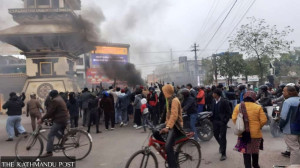National
Nepal and India to ink long-term energy deal early next week
The plan is to sign it in New Delhi on June 18 when Energy Secretary Dinesh Kumar Ghimire travels to India.
Anil Giri
Senior Nepali and Indian officials are set to sign the final agreement on a long-term energy deal next week. During the recent India visit of Prime Minister Pushpa Kamal Dahal, the sides had agreed in principle that India would import 10,000 megawatts of electricity from Nepal in the next 10 years.
An initial agreement was signed between Nepal and India at the energy secretary-level on June 2 in New Delhi following delegation-level talks between Dahal and his Indian counterpart, Narendra Modi. But due to a lack of time, approval of the Cabinets of the two countries couldn’t be obtained and the final text could not be signed during the visit, a senior official privy to the developments told the Post. “Now the two sides have concluded required processes and the agreement is ready to be signed.”
The two sides are tentatively planning to sign the agreement on June 18 in New Delhi when Energy Secretary Dinesh Kumar Ghimire travels to India, sources said.
Prime Minister Dahal visited India from May 31 to June 3. The two sides reached or signed a slew of agreements and memoranda of understanding including on a long-term energy deal.
The two sides expressed satisfaction that the agreement on the long-term power trade that was completed during the visit will streamline the procedures for power trade and make it more predictable, said a statement issued by the Ministry of Foreign Affairs after the visit. “The prime minister of India stated that India aims to increase the quantum of hydropower imports from Nepal to India to 10,000 MW in the next 10 years.”
Madhu Kumar Bhetwal, spokesman at the Ministry of Energy, said that an initial agreement on the long-term power deal between Nepal and India was signed during Prime Minister Dahal’s visit and is awaiting formal signatures from both sides.
“We have only signed the initial agreement, and now we have to sign the final agreement. This agreement would address the knotty issue of management of energy that we produce from our rivers,” said Bhetwal.
“Both sides finalised an Agreement for Long-Term Power Trade wherein it was agreed to strive to increase the quantum of export of power from Nepal to India to 10,000 MW within a timeframe of 10 years and towards this end, take all necessary measures to encourage mutually-beneficial investments in Nepal’s hydropower generation sector and transmission infrastructure,” said a statement issued by the India’s Ministry of External Affairs on June 2.
“Last year, we had adopted a landmark vision document for cooperation in the power sector,” Modi said during the joint press conference with his Nepali counterpart at Hyderabad House on June 2.
“Following the delegation-level talks, taking this forward, a long-term power trade agreement has been signed between India and Nepal today. Cooperation in the power sector has been further strengthened by agreements on the Phukot-Karnali and Lower Arun Hydro-Electric projects,” said Modi.
“The agreement has six articles that have already been approved by the Nepali and Indian cabinets,” said a Nepali diplomat.
The agreement is an umbrella agreement, said Bhetwal. “Although it talks about exporting energy for 10 years to India, it can be revisited when necessary.” He added that the text is flexible and that any provision can be changed, if needed, as per the recommendations of the two mechanisms led by the energy secretaries and joint secretaries of Nepal and India respectively.
In order to discuss issues related to energy, water resources, inundation and power trade, Nepal and India have set up two permanent mechanisms—one at the secretary level (the Joint Steering Committee) and the other at the level of joint-secretary (the Joint Working Group).
Meanwhile, if any change or amendment is needed in the proposed long-term power agreement, recommendations of these two mechanisms will be sought, officials added.




 6.84°C Kathmandu
6.84°C Kathmandu








%20(1).jpg&w=300&height=200)






